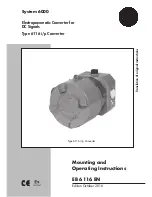
AUDIO KONTROL 1 – 78
For all
Buttons
, there are three
Hardware Event Modes
: each Button can be used
in
Trigger mode
,
Toggle mode
, or in
Modifier mode
, resulting in different hardware
events:
In
Trigger mode
, pressing the Button and releasing it creates Press and Release
events respectively. Both hardware events can be assigned to software events.
For example, pressing the Left Button could switch the TRAKTOR 3 LE Master
Effect on, and releasing the Button could switch it back off.
In
Toggle mode
, pressing the Button creates an On event; pressing it a second
time creates an Off event. Releasing the Button does not create any event.
Both On and Off events can be assigned to software events. For example,
pressing the Right Button could start the playback in iTunes®, and pressing
it again could pause the playback (like a Play/Pause button).
In
Modifier mode
, pressing or releasing the Button does
not
create any event.
Instead, the settings for all other Controllers are modified as long as the Button
is held. (Obviously, it cannot modify itself). This is similar to a computer
keyboard’s Shift key or Ctrl key that modifies another key’s assignment and
functionality. For example, in KORE PLAYER, the Controller Knob could move
the Sound Variation Morph horizontally when no Button is pressed, and verti-
cally when the Right Button is pressed. The Right Buttons acts as a
Modifier
.
7.3.3. The concept of Layers, or Making Multiple Uses of One Button
This Modifier function results in four different
Layers
of hardware events: The
Main
Layer
contains all events that are generated without any modifier. The
other three
Layers
are only available if the corresponding Button is set to Modifier mode in the
Main Layer.
The Modifier Mode is only available in the Main Layer. This means in par-
ticular that you cannot use modifier combinations to define a hardware event
(as you could on a computer keyboard with e.g. Ctrl+Shift+A).
►
►
►
















































